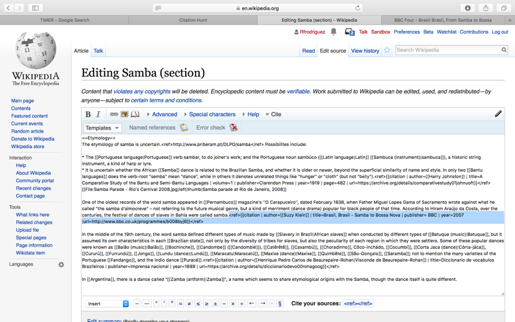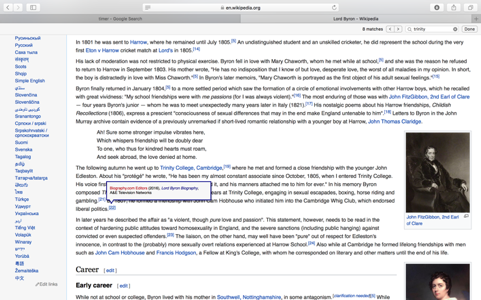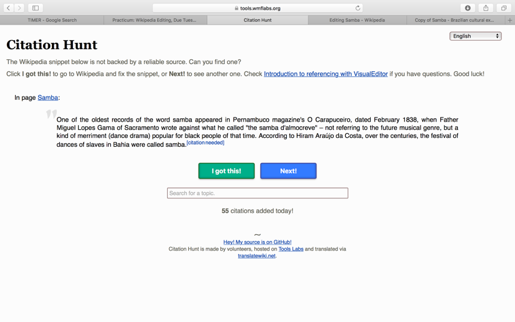I initially found the prospect of contributing to Wikipedia to be a daunting task, especially after having read David Auerbach’s article “Encyclopedia Frown” on Wikipedia’s editing disputes. But two exercises helped acclimate me to the process of editing a Wikipedia page.
Form my first exercise, I researched and added a citation where one was needed. I began by visiting the Citation Hunt project page to see a randomly generated instance where Wikipedia could use my help.

Source code for Samba reference.
After clicking “I got this,” I was taken to the Samba page where I could enter the VisualEditor. I Googled the quote to find an original source and stumbled upon a Prezi presentation that linked to a BBC documentary, where, it turns out, is where the quote came from. As such, I went back to the Samba page, clicked “Edit,” and studied the format for adding a reference. I copied another citation just to be safe before entering my own. I knew my entry was successful when I returned to the main page and saw the citation displayed.

New citation displayed on the Samba Wikipedia page.
My next exercise was to add content to add or edit content on a page that covered a topic of which I was familiar. I first used a bibliography to find a Wikipedia page that needed help, but was overwhelmed by the myriad of options. Consequently, I used the search box to find a Romantic poet who I was currently studying in my Romanticism course – Lord Byron.

Lord Byron’s Wikipedia page with new content.
I read the page in its entirety before noticing that the editors left out several details that I thought were critical to understanding Byron. (1) His habitation with the struggling poet Percy Bysshe Shelley in Italy. (2) His ability to subvert accepted and acknowledge gender serotypes. (3) How he spent his three years at Trinity College. Adding this information was simple. All I had to do was find sources to validate these claims, paraphrase the information in the VisualEditor, and then add a citation after each piece of information.

Assuring that my infromation is properly cited and displayed.
My experience contributing to Wikipedia helped shed light on the platform’s democratic aspects. Although I was logged in while contributing, I could have been an anonymous user and submitted the same information. That the website allows for everyone to have a say in the online encyclopedia speaks to its digital activism. Wikipedia is a crowdsourcing project that has made information more digestible and accessible to all. It is no wonder the website has become the first place that people turn to when learning about a topic.
ALL PHOTOS USED IN THIS POST ARE LICENSED UNDER THE CREATIVE COMMONS LICENSE

One response to “Wikipedia – a Democratic Crowd-Sourcing Project”
Great job overcoming anxiety about contributing to Wikipedia (no thanks to my reading assignment – apologies). I’m glad you had such a positive experience. Of course I’m biased, but I am particular excited about your additions to the Byron page. Byron is a Big Deal!, a very well-known figure whose page gets a lot of views, I bet. Which sources did you find and use to support your paraphrasing of these claims? Is there anything interesting on the Byron talk page? Just being a nosy Romanticist 🙂